A dust extractor is an essential tool for maintaining a clean and safe environment in any woodworking shop. Woodworking creates a significant amount of dust, which can be harmful to both your health and your equipment. A dust extractor efficiently captures sawdust, wood chips, and debris from power tools, ensuring your workspace remains tidy and the air stays clean.
By connecting directly to saws, sanders, or routers, dust extractors prevent fine dust particles from circulating in the air, reducing the risk of respiratory issues. They also help protect your tools from dust buildup, which can cause malfunction or premature wear.
Investing in a good dust extractor not only enhances your workshop’s cleanliness but also boosts productivity and safety. It’s a must-have for any woodworker looking to maintain a healthier and more efficient workspace.
Our Top Dust Extractor Picks
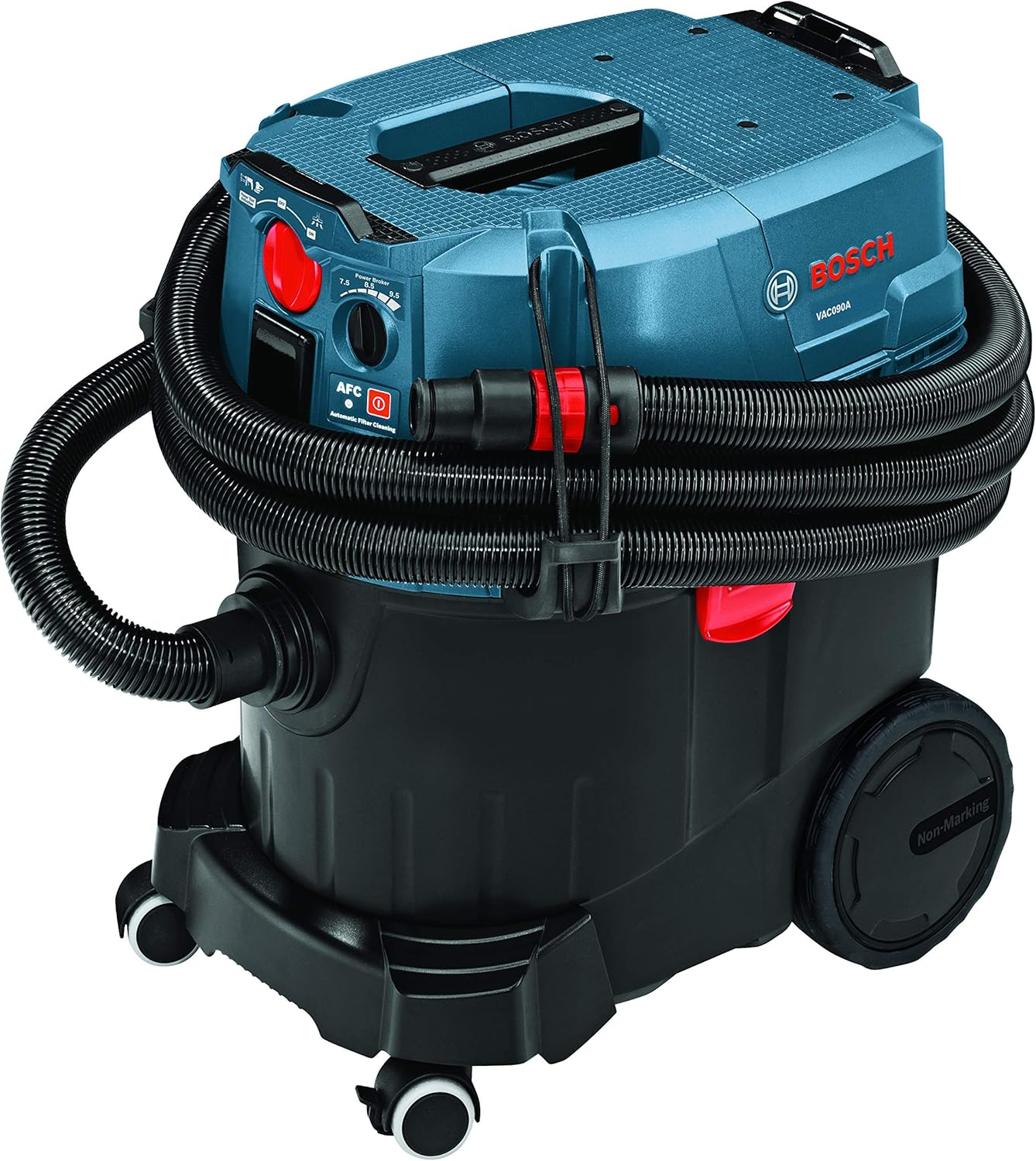
BOSCH VAC090AH Portable 9 Gallon Dust Extractor
Check on AmazonKey Specs
- Tank Capacity: 9 Gallons
- Airflow: 150 CFM
- Static Water Lift: 97 inches
- Filter: HEPA, captures 99.97% of particles at 0.3 microns
- Weight: 28 Pounds
The BOSCH VAC090AH Portable 9-Gallon Dust Extractor is designed for efficient dust collection in demanding environments. It features an automatic filter cleaning system that activates every 15 seconds, ensuring maximum suction power. Equipped with a HEPA filter, it captures 99.97% of particles as small as 0.3 microns. With a maximum airflow of 150 CFM and a static water lift of 97 inches, this extractor provides powerful performance. It is OSHA compliant and ideal for concrete work with tool-activated operation.
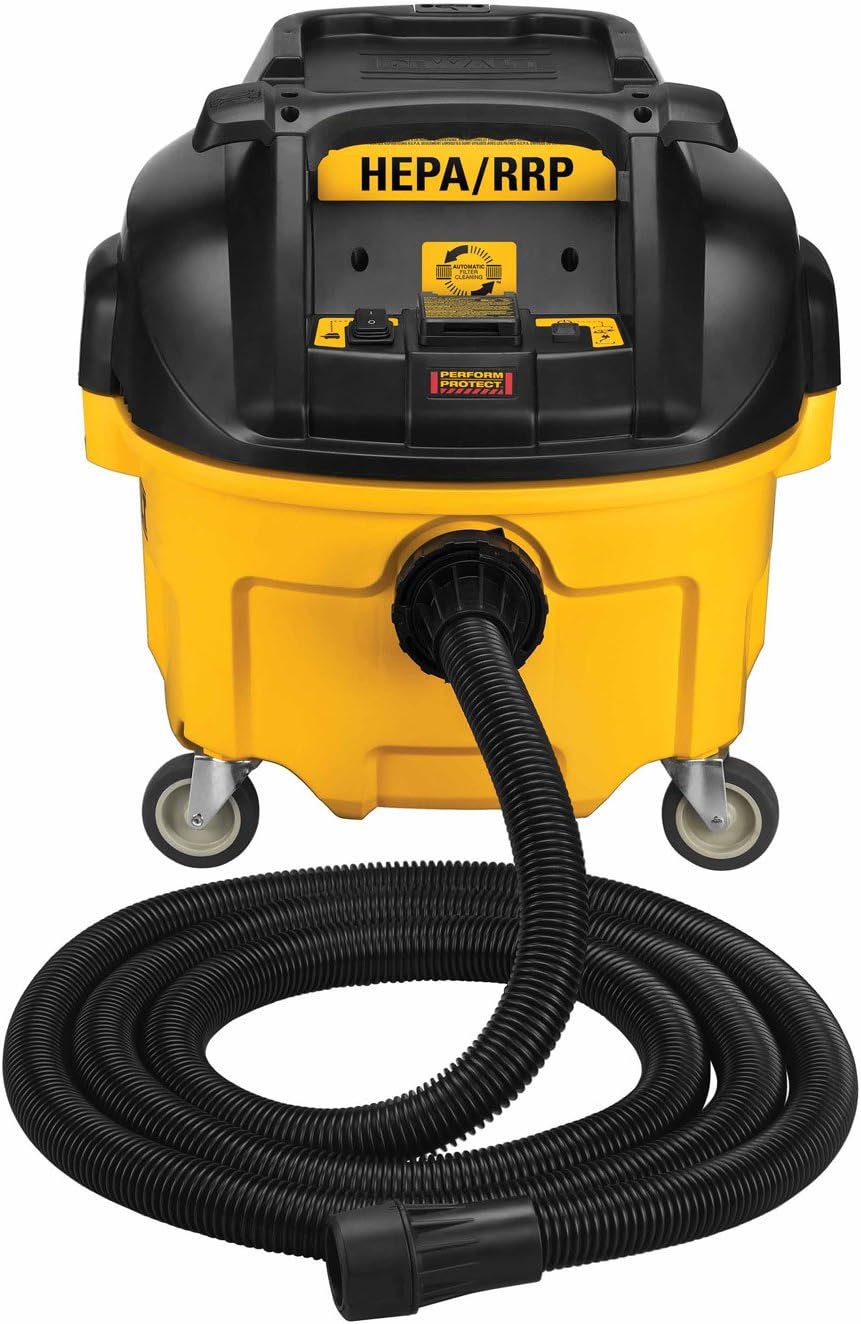
DEWALT DWV010 HEPA Dust Extractor
Check on Amazon
Key Specs:
- Airflow: 150 CFM
- Filter Type: HEPA Cartridge
- Motor: 15-Amp
- Hose: 15 ft, 1.25-inch diameter
- Weight: 22 Pounds
The DEWALT DWV010 HEPA Dust Extractor is designed to provide powerful, continuous dust collection with its automatic filter cleaning system, which pulses every 30 seconds. Featuring a 15-amp motor, it delivers 150 CFM airflow and has power tool actuation for easy on/off operation with a connected tool. This portable extractor meets EPA Lead RRP Rule compliance when paired with DWV9330 filters. It comes with heavy-duty wheels, a 15 ft. anti-static hose, and a universal hose connector for added convenience.
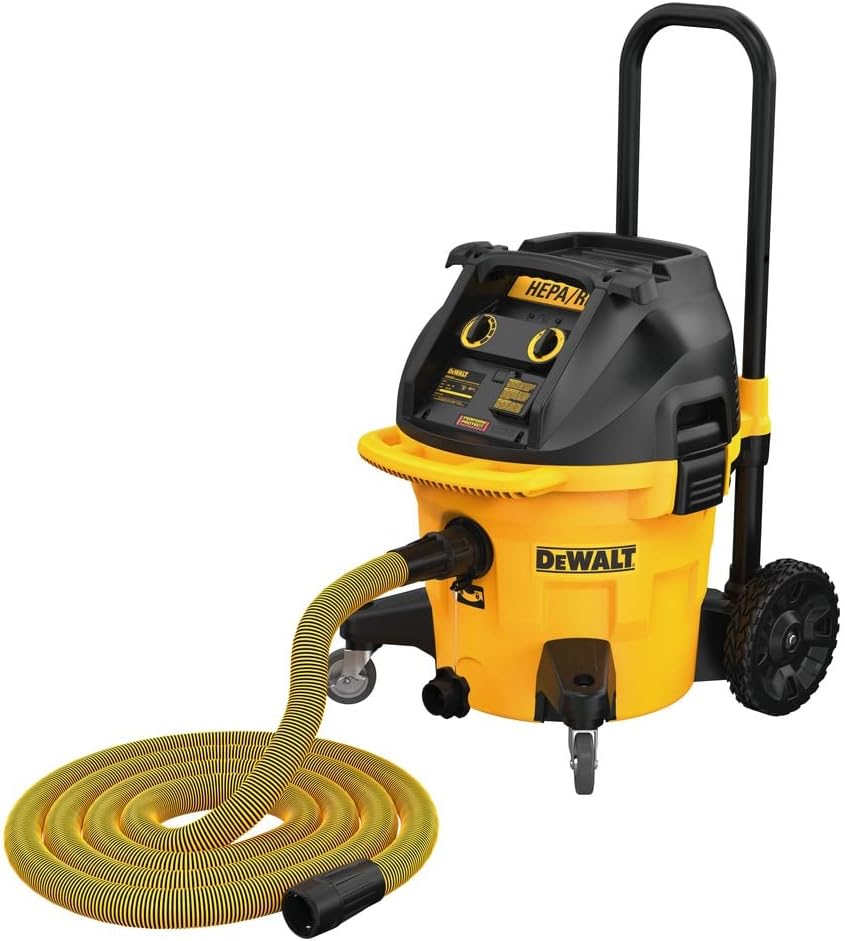
DEWALT 10 Gal. Dust Extractor
Check on AmazonKey Specs:
- Airflow: 155 CFM
- Filter Type: HEPA
- Capacity: 10 Gallons
- Special Feature: Wet, Dry, HEPA
- Automatic Filter Clean: Pulses every 30 seconds
The DEWALT 10 Gal. Dust Extractor is designed for powerful suction with a 155 CFM airflow, ideal for various jobsite tasks. Its automatic filter cleaning system ensures continuous operation without interruptions. The extractor features the DEWALT AirLock system to minimize dust exposure and improve cleanup. A storage accessory rack is compatible with TSTAK and TOUGHSYSTEM solutions, offering enhanced mobility and durability. The durable latches provide secure connections during transport over rugged jobsite conditions.
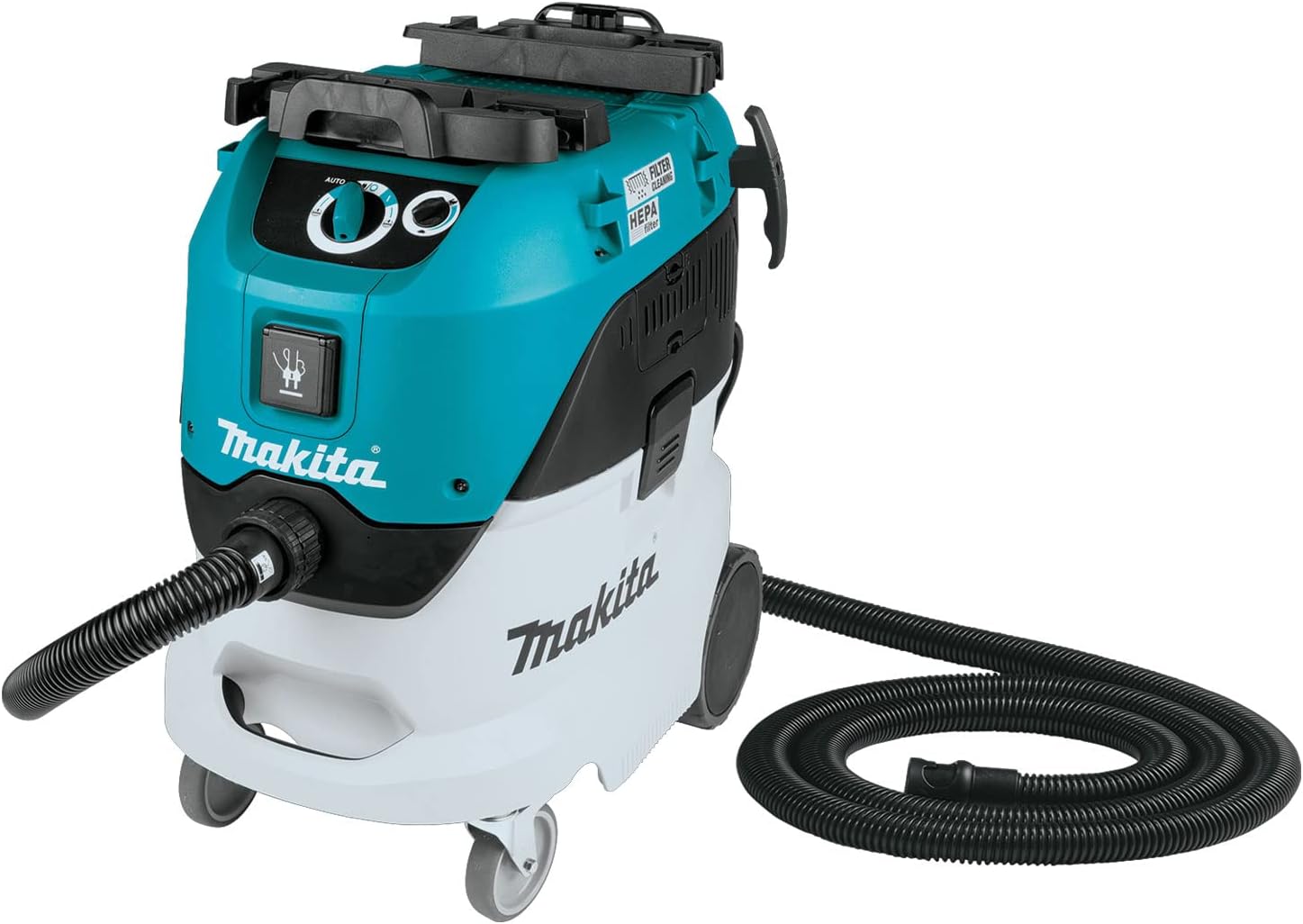
Makita VC4210L 11 Gallon Wet/Dry HEPA Filter Dust Extractor
Check on AmazonKey Specs:
- Airflow: 148 CFM
- Water Lift: 92″
- Filter Type: HEPA
- Capacity: 11 Gallons
- Special Feature: Wet/Dry, Automatic Filter Cleaning
The Makita VC4210L 11 Gallon Wet/Dry HEPA Filter Dust Extractor delivers powerful suction with a 12 AMP motor generating 148 CFM and 92″ of water lift. It features an automatic filter cleaning system to prolong filter life and a HEPA filter that captures 99.97% of particles 0.3 microns and larger. The two-stage filtration system ensures efficient dust extraction, while the onboard tool-activated power outlet helps manage vacuum operation with a 10-second delay.
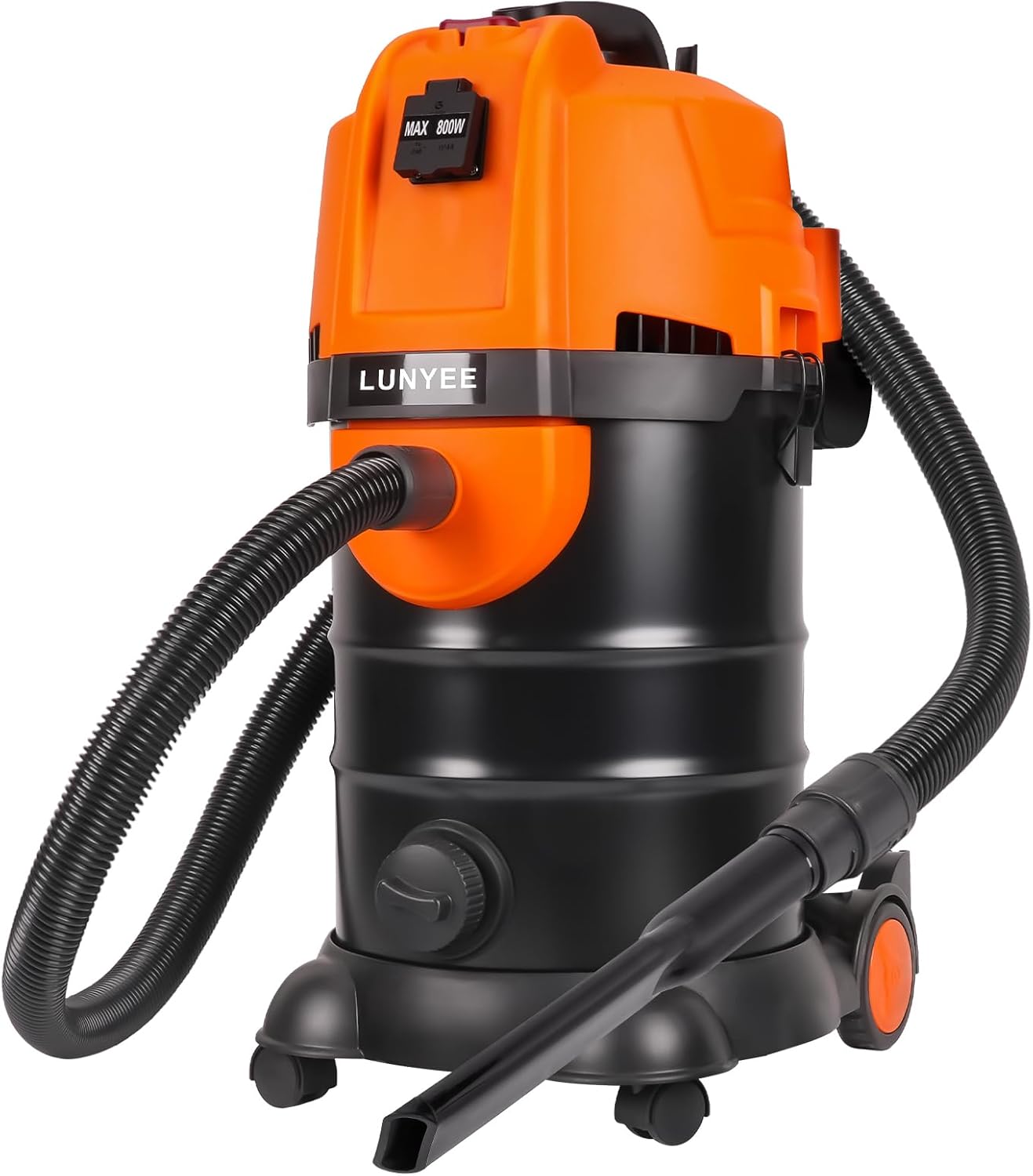
LUNYEE Dust Extractor
Check on AmazonKey Specs:
- Suction Power: 19,000 Pa
- Capacity: 7.9 Gallons
- Filtration: 99.97% HEPA filter
- Operating Range: 27 feet
- Features: Wet/Dry/Blow, Anti-tangle Hose
The LUNYEE Dust Extractor is a versatile tool designed for woodworking and construction sites. It features a powerful automatic vacuum switch that syncs with various tools like CNC machines, ensuring efficient dust collection. With a SuperCyclone system and HEPA filter, it captures 99.97% of particles as small as 3 microns. This dual-function dust collector and vacuum also handles wet and dry use, with a suction power of 19,000 Pa. It includes a premium anti-tangle hose, power cord, and adapters for enhanced convenience.
The Importance of Dust Extractors in Woodworking
As a woodworking enthusiast, you may already be familiar with the concept of a dust extractor. However, for those new to the craft, a dust extractor is a vital piece of equipment designed to remove dust and debris generated during woodworking processes. It consists of a motor that creates suction, pulling in dust particles through a hose and into a collection bag or canister. This ensures a cleaner and safer working environment by effectively managing airborne particles.
In woodworking, the importance of dust extraction cannot be overstated. Not only does it contribute to a healthier workspace, but it also plays a significant role in maintaining the longevity of your tools and equipment. By investing in a quality dust extractor, you not only prioritize your health but also enhance the overall efficiency and safety of your woodworking projects.
Health Benefits of Using a Dust Extractor
One of the primary advantages of utilizing a dust extractor in woodworking is the significant impact it has on health. Wood dust contains various particles that, when inhaled, can lead to respiratory issues such as coughing, wheezing, and even more severe conditions like asthma. By effectively capturing and containing these particles, a dust extractor helps reduce the risk of developing such health problems.
Moreover, long-term exposure to wood dust has been linked to more serious health concerns, including lung diseases and certain types of cancer. By incorporating a dust extractor into your woodworking setup, you not only prioritize your immediate well-being but also take proactive steps to prevent potential long-term health complications. This investment in health is invaluable for both hobbyists and professional woodworkers alike.
Health Benefits of Using a Dust Extractor:
1. Reduction of respiratory issues
2. Prevention of long-term health problems
3. Improved air quality in the workshop
| Health Benefits of Using a Dust Extractor |
|——————————————|
| 1. Reduction of respiratory issues |
| 2. Prevention of long-term health problems |
| 3. Improved air quality in the workshop |
Safety Benefits of Using a Dust Extractor
In addition to health considerations, the safety benefits of employing a dust extractor in woodworking are equally crucial. Wood dust is highly flammable and can pose a significant fire hazard if not properly managed. By promptly removing dust particles from the air and work surfaces, a dust extractor helps decrease the risk of fire accidents in the workshop, ensuring a safer working environment for all.
Furthermore, accumulated dust on the floor or machinery can lead to slip and fall accidents, jeopardizing the well-being of woodworkers. A dust extractor plays a pivotal role in minimizing these risks by maintaining a clean and clutter-free workspace. By prioritizing safety through the use of a dust extractor, woodworkers can focus on their craft with peace of mind.
Safety Benefits of Using a Dust Extractor:
1. Decreased risk of fire hazards
2. Minimization of slip and fall accidents
3. Enhanced workshop safety measures
| Safety Benefits of Using a Dust Extractor |
|—————————————–|
| 1. Decreased risk of fire hazards |
| 2. Minimization of slip and fall accidents |
| 3. Enhanced workshop safety measures |
Protection of Woodworking Equipment
Beyond health and safety considerations, a dust extractor also plays a crucial role in safeguarding your woodworking equipment. Wood dust has a notorious reputation for clogging machinery, leading to decreased performance and potential damage over time. By effectively capturing dust at the source, a dust extractor prevents clogs and ensures the smooth operation of your tools, ultimately prolonging their lifespan.
Additionally, the accumulation of dust on tools and equipment can accelerate wear and tear, necessitating frequent maintenance and replacements. By implementing a dust extraction system, woodworkers can mitigate these issues and extend the durability of their valuable woodworking assets. Protecting your equipment through proper dust extraction practices is a proactive measure that pays off in the long run.
Protection of Woodworking Equipment:
1. Prevention of clogging in machinery
2. Prolonged lifespan of tools and equipment
3. Reduction in maintenance costs
| Protection of Woodworking Equipment |
|————————————|
| 1. Prevention of clogging in machinery |
| 2. Prolonged lifespan of tools and equipment |
| 3. Reduction in maintenance costs |
Improved Workshop Environment
In addition to the health, safety, and equipment benefits, a dust extractor contributes to an overall improved workshop environment. Woodworking generates a significant amount of airborne dust particles that can settle on surfaces, affecting visibility and cleanliness. By capturing and containing these particles, a dust extractor helps reduce airborne dust, creating a cleaner and healthier workspace for woodworkers.
Furthermore, a cleaner workshop enhances visibility, allowing for better precision and attention to detail in woodworking projects. With reduced dust in the air, woodworkers can focus on their craft without distractions, leading to improved productivity and quality of work. The enhanced workshop environment facilitated by a dust extractor sets the stage for successful and enjoyable woodworking endeavors.
Improved Workshop Environment:
1. Reduction of airborne dust particles
2. Enhanced visibility and cleanliness in the workspace
3. Improved focus and productivity in woodworking projects
| Improved Workshop Environment |
|——————————|
| 1. Reduction of airborne dust particles |
| 2. Enhanced visibility and cleanliness in the workspace |
| 3. Improved focus and productivity in woodworking projects |
Compliance with Regulations
In the realm of woodworking, regulatory compliance is a critical aspect that cannot be overlooked. Occupational Safety and Health Administration (OSHA) guidelines mandate the control of wood dust exposure in the workplace to protect the health and safety of workers. By utilizing a dust extractor, woodworkers not only adhere to OSHA requirements but also demonstrate a commitment to upholding industry standards and best practices.
Failure to comply with dust control regulations can have legal implications, potentially resulting in fines and penalties for non-compliance. By investing in a dust extraction system and prioritizing a safe working environment, woodworkers can avoid legal troubles and operate within the bounds of the law. Compliance with regulations is not just a matter of legality but also a fundamental aspect of responsible woodworking practices.
Compliance with Regulations:
1. OSHA requirements for dust control
2. Legal implications of not using a dust extractor
3. Upholding industry standards for workplace safety
| Compliance with Regulations |
|—————————-|
| 1. OSHA requirements for dust control |
| 2. Legal implications of not using a dust extractor |
| 3. Upholding industry standards for workplace safety |
Cost Savings in the Long Run
While the initial investment in a dust extractor may seem like an added expense, the long-term cost savings it offers are substantial. By prioritizing health, safety, and equipment protection through dust extraction, woodworkers can avoid potential medical expenses associated with dust-related health issues. The preventive nature of dust extraction ultimately leads to savings in healthcare costs and promotes overall well-being.
Moreover, by reducing the accumulation of dust on machinery and tools, a dust extractor helps minimize the need for frequent maintenance and repairs. This translates to lower equipment maintenance costs over time, allowing woodworkers to allocate their resources more efficiently. The cost savings achieved through the use of a dust extractor make it a wise investment for both personal health and financial well-being.
Cost Savings in the Long Run:
1. Avoidance of potential medical expenses
2. Reduction in equipment maintenance costs
3. Efficient allocation of resources in woodworking projects
| Cost Savings in the Long Run |
|—————————–|
| 1. Avoidance of potential medical expenses |
| 2. Reduction in equipment maintenance costs |
| 3. Efficient allocation of resources in woodworking projects |
Efficiency in Woodworking Projects
In the realm of woodworking, efficiency is key to achieving successful and satisfying results. A clean and organized workspace is essential for maintaining a smooth workflow and focusing on the craftsmanship at hand. By incorporating a dust extractor into your woodworking setup, you ensure an uninterrupted workflow by eliminating distractions caused by dust accumulation, allowing you to concentrate on honing your skills and creating masterful pieces.
Furthermore, with a dust-free environment facilitated by a dust extractor, woodworkers can shift their focus from cleanup tasks to the actual woodworking process. This transition from maintenance to creation enhances efficiency and productivity in woodworking projects, enabling woodworkers to unleash their creativity and achieve optimal results. Embracing dust extraction not only promotes a cleaner workspace but also elevates the quality of craftsmanship.
Efficiency in Woodworking Projects:
1. Uninterrupted workflow due to clean workspace
2. Focus on craftsmanship rather than cleanup
3. Enhanced productivity and creativity in woodworking endeavors
| Efficiency in Woodworking Projects |
|———————————-|
| 1. Uninterrupted workflow due to clean workspace |
| 2. Focus on craftsmanship rather than cleanup |
| 3. Enhanced productivity and creativity in woodworking endeavors |
Types of Dust Extractors Available
When considering the implementation of a dust extraction system in your woodworking workshop, it’s essential to explore the various types of dust extractors available on the market. Two primary categories of dust extractors include portable dust extractors and stationary dust collection systems, each offering unique features and benefits to cater to different woodworking needs and preferences.
Portable dust extractors are versatile and convenient, ideal for smaller workshops or on-the-go woodworking projects. These compact units are easy to move around and can be connected to individual tools for targeted dust extraction. On the other hand, stationary dust collection systems are more robust and suitable for larger workshops with multiple woodworking stations. These systems typically feature powerful motors and extensive ductwork to effectively capture dust from various sources.
Types of Dust Extractors Available:
1. Portable dust extractors
2. Stationary dust collection systems
3. Versatility and convenience of portable units vs. power and capacity of stationary systems
| Types of Dust Extractors Available |
|———————————–|
| 1. Portable dust extractors |
| 2. Stationary dust collection systems |
| 3. Versatility and convenience of portable units vs. power and capacity of stationary systems |
Factors to Consider When Choosing a Dust Extractor
Selecting the right dust extractor for your woodworking workshop involves considering several key factors to ensure optimal performance and efficiency. Airflow capacity is a crucial aspect to evaluate, as it determines the suction power of the dust extractor and its ability to capture dust effectively. A higher airflow capacity is generally preferred for larger workshops or heavy-duty woodworking tasks.
Filtration efficiency is another essential factor to keep in mind when choosing a dust extractor. High-quality filters ensure that fine dust particles are effectively captured and contained, preventing them from circulating back into the air. Additionally, the size of your workshop plays a significant role in selecting a dust extractor, as the unit’s capacity should align with the volume of dust generated in your workspace to maintain a clean and healthy environment.
Factors to Consider When Choosing a Dust Extractor:
1. Airflow capacity for optimal suction power
2. Filtration efficiency to capture fine dust particles
3. Matching the unit size to the workshop volume for effective dust extraction
| Factors to Consider When Choosing a Dust Extractor |
|————————————————–|
| 1. Airflow capacity for optimal suction power |
| 2. Filtration efficiency to capture fine dust particles |
| 3. Matching the unit size to the workshop volume for effective dust extraction |
Proper Maintenance of Dust Extractors
To ensure the continued effectiveness and longevity of your dust extractor, proper maintenance practices are essential. Regular cleaning of filters is crucial to prevent clogging and maintain optimal airflow and suction power. Depending on the frequency of use, filters should be cleaned or replaced as recommended by the manufacturer to uphold the dust extractor’s performance.
Additionally, emptying dust collection bags or canisters in a timely manner is vital to prevent overflow and maintain the unit’s efficiency. Accumulated dust can obstruct airflow and reduce the dust extractor’s effectiveness in capturing particles. By adhering to a routine maintenance schedule and following manufacturer guidelines, woodworkers can prolong the lifespan of their dust extractor and maximize its dust extraction capabilities.
Proper Maintenance of Dust Extractors:
1. Regular cleaning of filters to prevent clogging
2. Timely emptying of dust collection bags or canisters
3. Following manufacturer guidelines for maintenance and replacement
| Proper Maintenance of Dust Extractors |
|————————————-|
| 1. Regular cleaning of filters to prevent clogging |
| 2. Timely emptying of dust collection bags or canisters |
| 3. Following manufacturer guidelines for maintenance and replacement |
Common Mistakes to Avoid When Using a Dust Extractor
While a dust extractor is a valuable tool in woodworking, certain common mistakes can compromise its effectiveness and impact on the workshop environment. Neglecting to wear personal protective equipment, such as dust masks or goggles, can expose woodworkers to harmful dust particles, counteracting the benefits of the dust extractor. It is essential to prioritize safety by using appropriate gear when operating woodworking machinery.
Another critical mistake to avoid is overlooking the importance of proper ventilation in conjunction with a dust extractor. Adequate airflow in the workshop helps disperse airborne dust particles and supports the dust extractor’s function in capturing dust effectively. By maintaining proper ventilation and using a dust extractor in tandem, woodworkers can create a safer and healthier working environment for themselves and their colleagues.
Common Mistakes to Avoid When Using a Dust Extractor:
1. Neglecting to wear personal protective equipment
2. Overlooking the importance of proper ventilation
3. Ensuring safety and effectiveness through gear and ventilation practices
| Common Mistakes to Avoid When Using a Dust Extractor |
|—————————————————–|
| 1. Neglecting to wear personal protective equipment |
| 2. Overlooking the importance of proper ventilation |
| 3. Ensuring safety and effectiveness through gear and ventilation practices |
Case Studies of Woodworkers Benefiting from Dust Extractors
To illustrate the tangible impact of dust extractors on woodworking practices, let’s delve into some case studies featuring testimonials from professionals in the industry. Woodworkers who have integrated dust extraction systems into their workshops have reported significant improvements in their health, productivity, and overall satisfaction with their craft. These firsthand accounts highlight the transformative effects of prioritizing dust extraction in woodworking environments.
Furthermore, examples of enhanced health and productivity resulting from the use of dust extractors showcase the real-world benefits that woodworkers can experience. By investing in a dust extraction system and embracing best practices for dust control, woodworking professionals have not only safeguarded their well-being but also elevated the quality of their work. These case studies serve as compelling evidence of the positive outcomes that stem from incorporating dust extraction into woodworking routines.
Case Studies of Woodworkers Benefiting from Dust Extractors:
1. Testimonials from professionals in the industry
2. Examples of improved health and productivity
3. Real-world impact of dust extraction on woodworking practices
| Case Studies of Woodworkers Benefiting from Dust Extractors |
|————————————————————|
| 1. Testimonials from professionals in the industry |
| 2. Examples of improved health and productivity |
| 3. Real-world impact of dust extraction on woodworking practices |
Steps to Implement Dust Extraction in a Workshop
For woodworkers looking to enhance their workshop environment and prioritize dust extraction, implementing a dust collection system is a crucial step. Setting up a dust collection system involves selecting the appropriate dust extractor for your needs, installing ductwork to connect the extractor to woodworking machinery, and positioning the unit strategically to capture dust effectively. By following these steps, woodworkers can establish a clean and safe working environment conducive to creativity and productivity.
Moreover, training employees on the proper usage of the dust extractor is essential to ensure its optimal performance and longevity. Educating workshop staff on maintenance practices, safety protocols, and the benefits of dust extraction fosters a culture of responsibility and care for the equipment. By empowering team members with the knowledge and skills to operate the dust extractor effectively, woodworkers can maximize its impact on the workshop environment.
Steps to Implement Dust Extraction in a Workshop:
1. Setting up a dust collection system
2. Training employees on proper usage
3. Establishing a culture of responsibility and care for the equipment
| Steps to Implement Dust Extraction in a Workshop |
|————————————————-|
| 1. Setting up a dust collection system |
| 2. Training employees on proper usage |
| 3. Establishing a culture of responsibility and care for the equipment |
Conclusion
In conclusion, the role of dust extractors in woodworking goes far beyond mere dust removal—it encompasses health, safety, equipment protection, efficiency, and compliance with regulations. By prioritizing dust extraction in woodworking practices, woodworkers not only safeguard their well-being and workspace but also enhance the quality of their craftsmanship. The benefits of using a dust extractor are multifaceted, contributing to a cleaner, safer, and more productive woodworking environment.
Woodworkers are encouraged to take proactive steps in implementing dust extraction systems, selecting the right equipment, and adhering to maintenance practices to maximize the benefits of dust extraction. By investing in a dust extractor and embracing best practices for dust control, woodworkers can elevate their woodworking experience, achieve optimal results, and enjoy a healthier and more efficient workshop environment. Let’s prioritize dust extraction in woodworking for a safer, cleaner, and more enjoyable woodworking journey.
Call to Action
As you embark on your woodworking projects, remember the importance of dust extraction in creating a safe and healthy workspace. Explore the various types of dust extractors available, consider the factors when choosing the right unit, and prioritize proper maintenance to maximize its effectiveness. By incorporating a dust extractor into your woodworking routine, you not only enhance your health and safety but also elevate the quality of your craftsmanship. Let’s make dust extraction a cornerstone of our woodworking practices for a brighter and cleaner woodworking future.
Call to Action:
1. Prioritize dust extraction in woodworking projects
2. Explore the benefits of using a dust extractor
3. Create a safer and healthier workspace for woodworking endeavors
| Call to Action |
|—————-|
| 1. Prioritize dust extraction in woodworking projects |
| 2. Explore the benefits of using a dust extractor |
| 3. Create a safer and healthier workspace for woodworking endeavors |
FAQ
What is the purpose of a dust extractor in woodworking?
A dust extractor in woodworking is designed to remove dust and debris generated during woodworking processes, ensuring a cleaner and safer working environment by effectively managing airborne particles.
How does a dust extractor benefit woodworkers?
A dust extractor offers health benefits by reducing respiratory issues and preventing long-term health problems. It also provides safety benefits by decreasing fire hazards and minimizing slip and fall accidents in the workshop.
What types of dust extractors are available for woodworking?
There are two primary types of dust extractors available for woodworking: portable dust extractors, which are versatile and convenient for smaller workshops, and stationary dust collection systems, which are more robust and suitable for larger woodworking setups.
How can woodworkers maintain their dust extractors for optimal performance?
Woodworkers can maintain their dust extractors by regularly cleaning filters to prevent clogging, emptying dust collection bags or canisters in a timely manner, and following manufacturer guidelines for maintenance and replacement.
Why is compliance with dust control regulations important in woodworking?
Compliance with dust control regulations, such as those set by OSHA, is crucial in woodworking to protect the health and safety of workers, avoid legal implications, and uphold industry standards for workplace safety.
